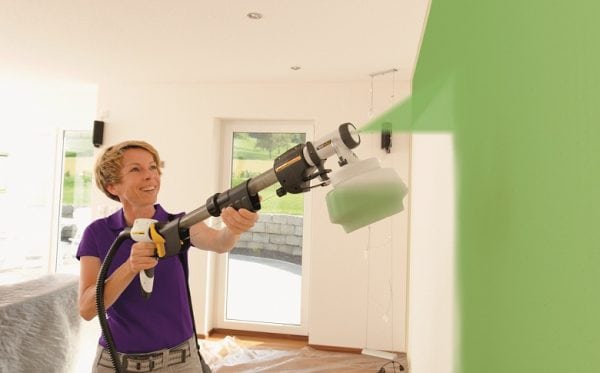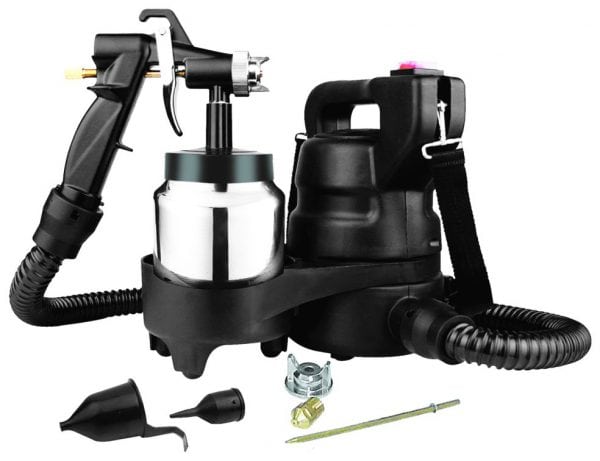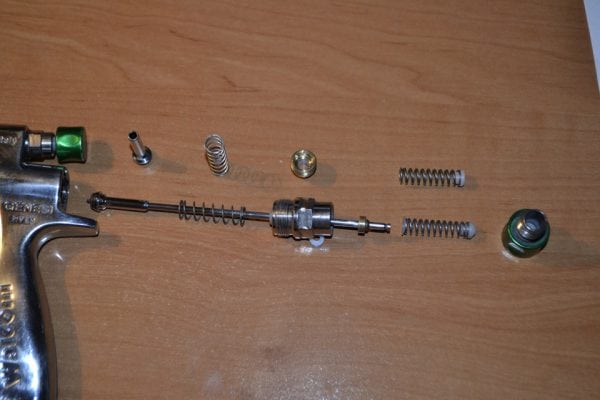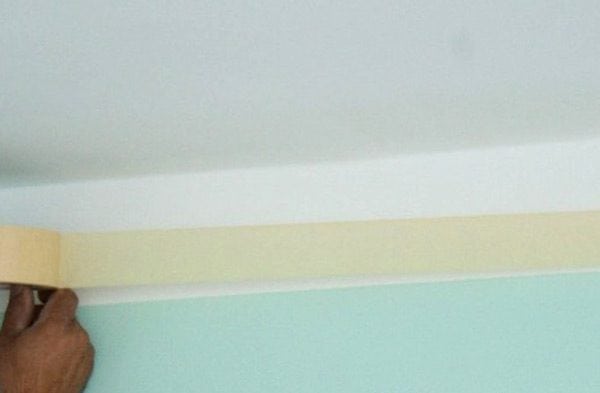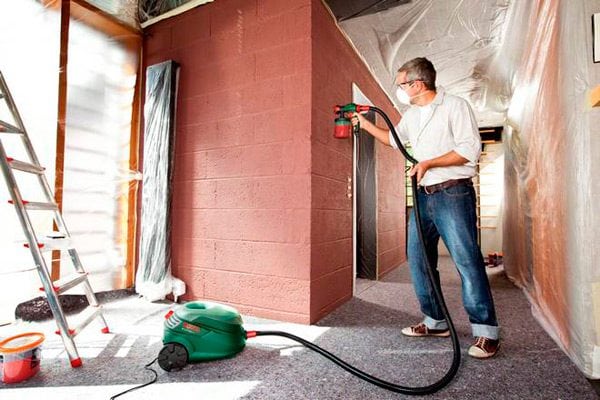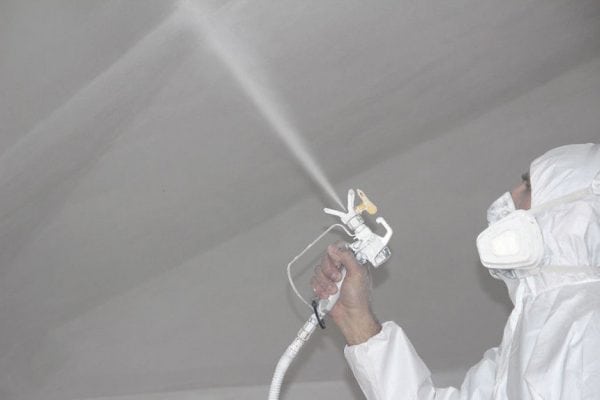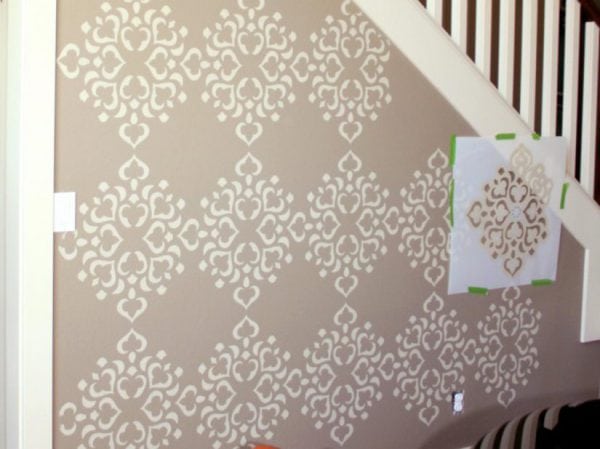When carrying out repair work, there is often a need for decorative painting of walls. It is very difficult to achieve high quality with a brush, and besides, such a method is the best choice, since working with this tool takes a lot of energy in large areas. The airbrush will allow to put paint on walls in the shortest possible time with the minimum expenses of work.
- Tools and materials
- Choosing the right spray gun
- Preparatory work
- Spray gun preparation
- Paint preparation
- Wall preparation
- Workplace preparation
- Paint application
- Coloring Textured Wallpaper
- Plaster painting
- Stencil painting
- Tips for using a spray gun
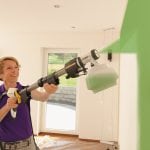
Tools and materials
For the work you will need the following:
- spray gun;
- an electric drill with a mixer nozzle, which will be needed to mix the paint material;
- a container for the composition (it will be stirred and, if necessary, tinted paint);
- measuring utensils;
- paint;
- masking tape;
- plastic film or paper to protect surfaces near the workplace.
Choosing the right spray gun
You can choose between three types of spray guns:
- pneumatic;
- electric;
- tame.
Pneumatics is used on professional equipment. Such spray guns can work with both water-based and any other types of paints. Pneumatic devices can be fine-tuned, which allows to achieve high quality painting. The spray capacity can reach up to 400 square meters per hour.
Electric models powered from the network are also popular among masters due to their compactness and ease of setup. However, the purpose of electric spray guns is more domestic due to more limited capabilities in comparison with pneumatic equipment. In addition, electrical devices are designed to work only with water-based compositions.
For insignificant areas, a manual airbrush is suitable. The design of such a device is extremely simple and reliable - a cylinder and a spray. Hand models are used for applying water-based paints. The pressure in the cylinder is created using a special lever, after which the composition is applied to the wall using a spray gun. The average productivity when working with manual equipment is 150-200 square meters per hour.
to contents ↑Preparatory work
Spray gun preparation
First, you have to collect the spray gun. To do this, we perform a series of sequential operations:
- We connect the handle and nozzle to the body and turn until it clicks. Next, connect the air hose. In this case, the hoses should not be pinched anywhere, since pinches will lead to a deterioration in the supply of paint.
- Adjust the position of the nozzle for feeding vertically and horizontally.
- We set up a round controller, which, if necessary, we will change the supply pressure of the paint material.
Paint preparation
We dilute the paint and varnish material and mix in the proportions indicated by the manufacturer on the package. Particular care should be taken when mixing the paint before tinting.The calculation of the required amount of material can be made, taking into account the quadrature of the surfaces to be painted.
Wall preparation
Instructions for preparing the surface before painting:
- We remove the old coating.
- We level the surface, freeing it from all kinds of defects using putty.
- We apply soil to the surface - it will provide better adhesion (adhesion of dissimilar materials). Apply the impregnating composition with a roller or spray. In hard to reach places you can use a brush.
to contents ↑Note! The paintwork composition can be applied only after the soil has completely dried, since otherwise the formation of paint defects is inevitable.
Workplace preparation
To work more conveniently, we perform the following actions:
- We collect scaffolding or a "goat". It is much easier and safer to work with these devices than with a stepladder. If the ceiling is low, you can use the usual strong table.
- The ceiling with a fine finish must be protected from paint. To this end, we glue the surface around the perimeter with masking tape. If desired, you can seal the entire surface with paper.
- We perform the same actions with respect to the floor and baseboard.
Advice! Experienced professionals are limited to sticky tape sticker, since their movements are verified and paint is unlikely to get on an undesirable surface. However, it is better for beginners to protect the maximum possible area from accidental ink.
to contents ↑Paint application
Coloring Textured Wallpaper
The application of paint to textured wallpaper is designed to give the surface a greater decorative effect. Even before starting the painting, carefully remove the housing of the outlets and seal them with masking tape. In this case, we isolate the wiring. Also do not forget about protecting surfaces that will not be painted, including windows and doors.
Advice! Working with a spray gun requires the use of protective clothing and glasses.
We fill the paint in the tank of the device. If necessary, we tint. Before starting the painting, it is recommended to make a few test emissions of paint to make sure the surface is uniform and the device is set correctly.
When applying paint, hold the spray gun at a right angle. Hand movements are smooth: from bottom to top. At the same time, we are not too late in one area, since textured wallpapers grasp paint materials so well. Particularly scrupulously we process corners. It is important not to allow unpainted areas.
to contents ↑Plaster painting
The spray gun can be used for plaster painting. To do this, you need to perform a certain sequence of operations:
- First, we prepare an approximately 10-liter container in which we add pigment and white paint. Thoroughly mix the composition, until a homogeneous consistency appears.
- If the mixture is too thick, add water to it and stir the contents well again.
- We connect the spray head to the spray gun.
- We make several test strokes on the test surface. If the test surface is homogeneous, you can start painting the plaster.
- The application of paint is carried out on the basis of the same principles as in the case of textured wallpaper.
Stencil painting
Often a stencil is used to give the wall an external appeal. Forms can be made independently or purchased ready-made. First of all, we apply the base material to the wall, which can be used as wallpaper, paint, plaster, lime, whitewash, etc.
Painting is carried out as follows:
- After applying the base coat, we expect it to dry completely.
- We fix the stencil on the surface.If it includes several elements, all of them are glued joint to joint. At the same time, we press the edges of the picture tightly to the surface, otherwise good work quality cannot be achieved.
- We spray paint the desired color with a spray gun. We set the minimum flow rate, since it is important to prevent penetration stencil paints. We apply the composition quickly, but smoothly.
- We wait until the surface dries a little. We carefully remove the stencil from the wall that has not yet completely dried up so as not to damage the paint layer.
- Next, we repeat the above-described work with the stencil again in other parts of the wall.
- When the entire wall is painted, it can be additionally coated with colorless varnish. This will help fix the pattern.
Tips for using a spray gun
The coating will turn out to be of high quality only with proper operation with a spray gun. For example, the spray gun should be no closer than 15 from the surface, but no further than 20 centimeters. Only in this case it is possible to achieve an even paint coat. However, if you want to get a tinted coating or to provide the effect of decorative splashes, the distance can be slightly increased.
Before starting work, it is recommended to practice on a wooden or cardboard sheet. This is necessary not only to hone skills, but also to adjust equipment. You may need to adjust the nozzle so that the stream is smoother, create the desired pressure, increase or decrease the ink supply, etc.
The main problems that may arise when working with a spray gun:
- The appearance of drips on the edges. Typically, the problem is an excessively high airflow. The solution is to reduce airflow or use a denser composition.
- Strong streaks under the middle of the spot. The problem occurs when there is an excess of paint. In this case, reducing the flow of paintwork or strengthening the air stream will help.
- The coating looks like dusty. The dust effect occurs due to too high viscosity of the composition. Necessary dilute paint for spray gun to a suitable consistency. This is done empirically with a preliminary test on a test surface.
Painting walls with a spray gun is convenient and much less labor-intensive than in the case of a roller and a brush. However, all work requires skill, and work with a spray gun, in addition to the ability to apply a layer of paint correctly, also requires some knowledge of the internal structure of the equipment. Therefore, before proceeding with painting, it is recommended that you study the rules for adjusting the spray gun and practice on test surfaces.

